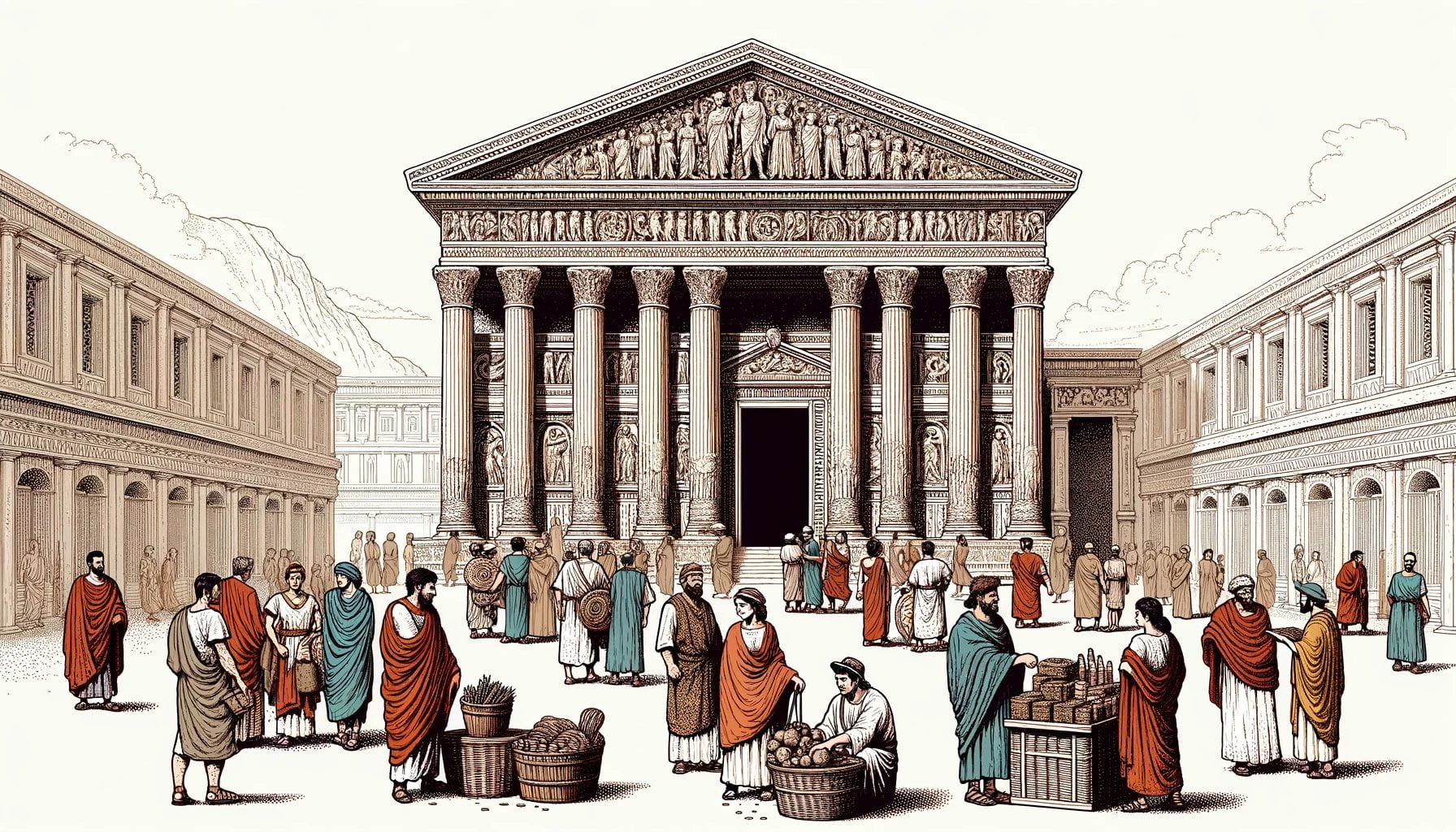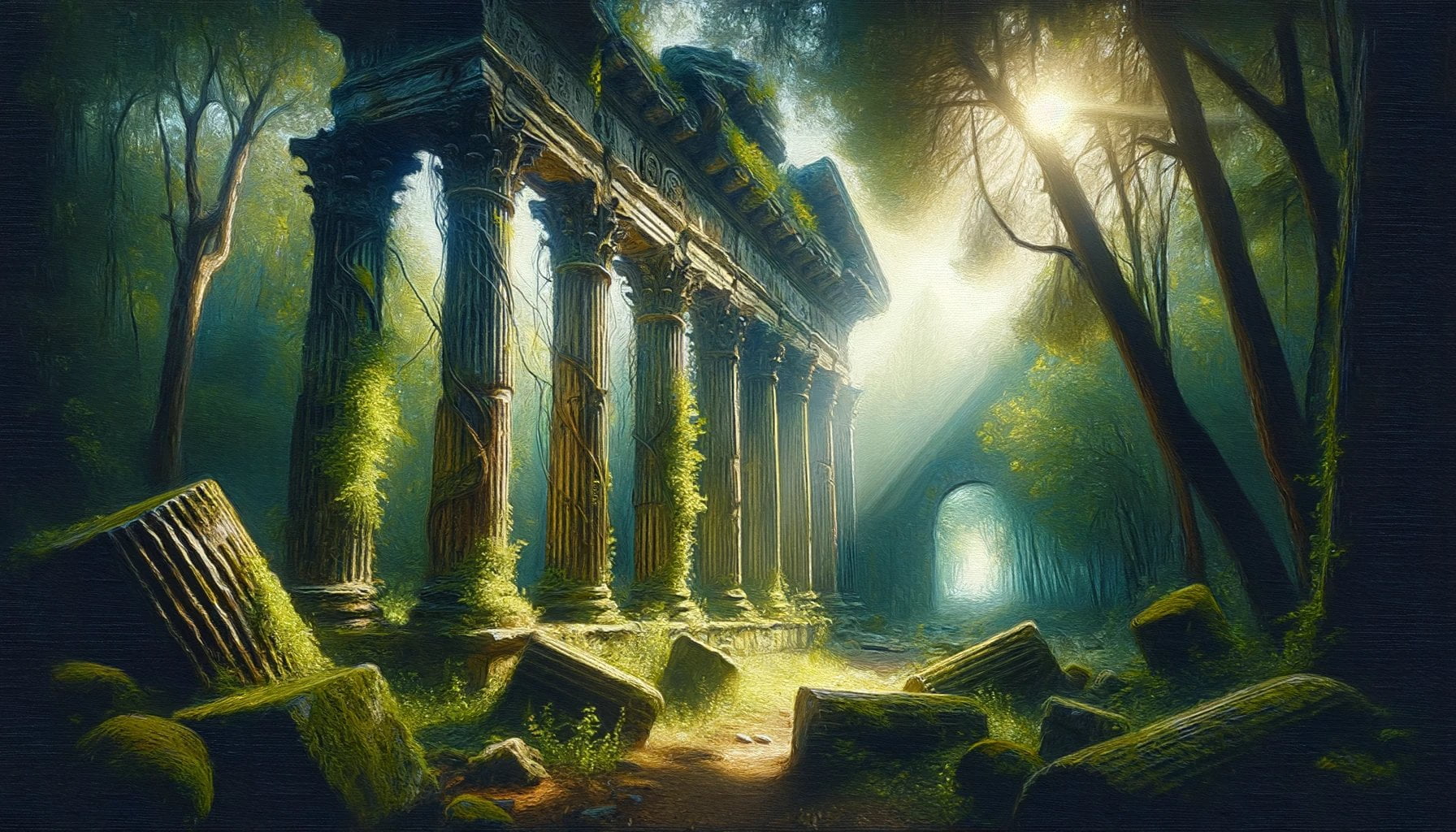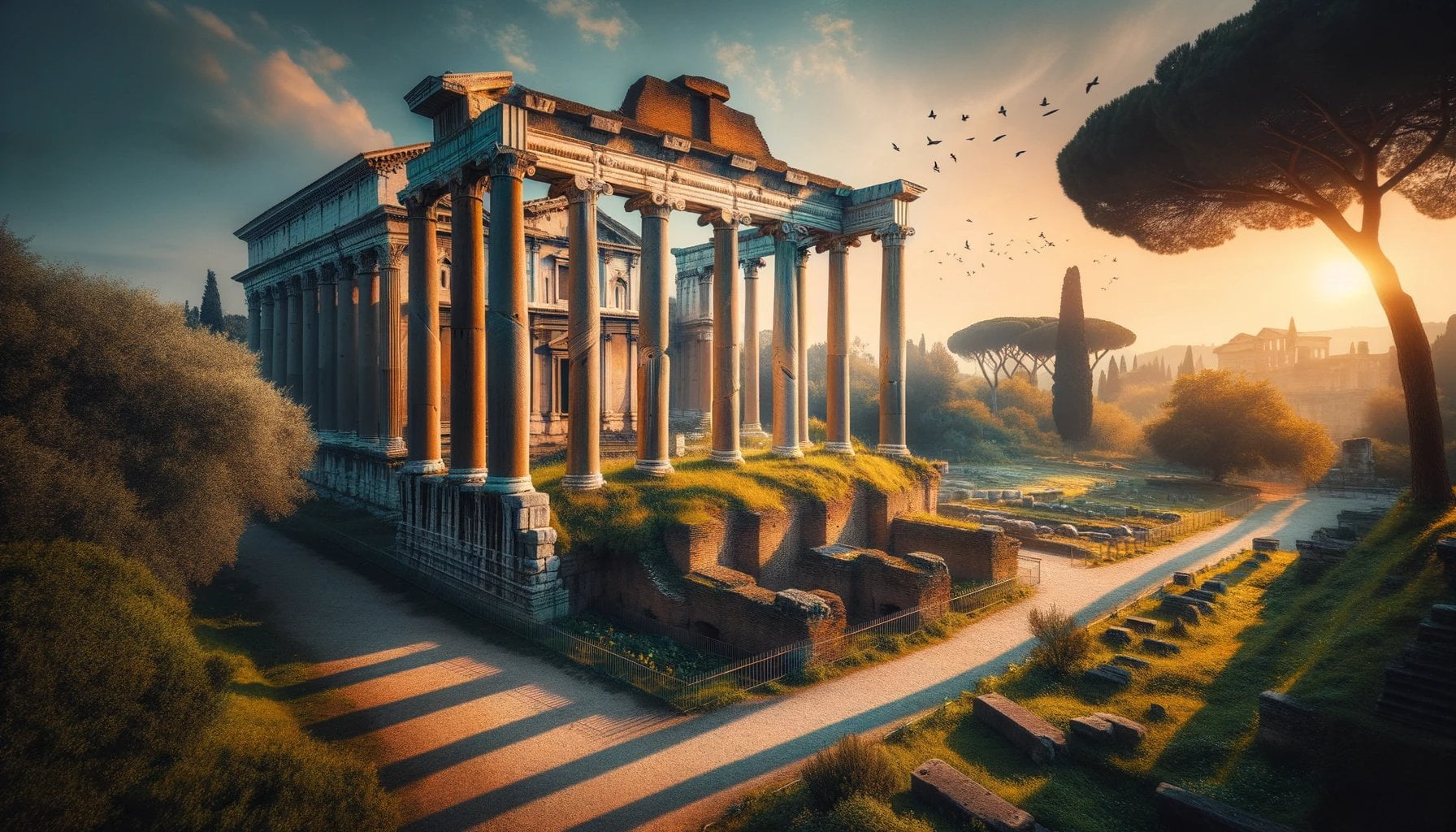Welcome to “Unveiling the Mysteries: Ancient Roman Temples in Focus,” where we embark on an enthralling journey through the captivating realm of ancient Roman temples. Step back in time and immerse yourself in the awe-inspiring world of these architectural wonders that stood as magnificent testaments to the Roman civilization’s spiritual and cultural legacy. As we survey these remnants of the ancient past, we will unravel the secrets behind their construction, explore their significance to the Roman society, and marvel at the intricate details that have withstood the test of time. Join us as we delve into the fascinating world of ancient Roman temples, shedding light on their mysteries one discovery at a time.

Key Takeaways:
- Ancient Roman temples have been repurposed into churches and mosques, but some in rural areas of the Islamic world remain undisturbed.
- Spain has made remarkable discoveries of ancient Roman temple remains in the 19th century.
- Rome, Pula, and other places have incorporated ancient Roman temple walls into later buildings.
- Loose stone pieces, like capitals, have been removed from temple sites and are displayed in local museums.
- Notable Roman temples that still have substantial remains include the Pantheon, Temple of Antoninus and Faustina, and Temple of Saturn.
- Italy, France, Britain, and Tunisia also have ancient Roman temples with ruins or fragments.
- The Temple of Claudius in Colchester, England, has a visible base in the basements of Colchester Castle.
- The Temple of Apollo in Pompeii has well-preserved smaller elements.
- The Maison Carrée in Nîmes, France, is one of the most complete surviving Roman temples.
- Rome has numerous temples with varying degrees of preservation, such as the Temple of Apollo Palatinus, Temple of Caesar, Temple of Venus and Roma, and Temple of Vespasian and Titus.
Ancient Roman Temples
When we think of ancient Rome, one of the first images that comes to mind is that of majestic temples, dedicated to the gods and goddesses worshipped by the Romans. These temples were not only architectural marvels but also held immense cultural and spiritual significance for the ancient Romans. In this article, we will delve into the world of ancient Roman temples, uncovering their secrets and shedding light on their historical and cultural context.
Architectural Marvels of Ancient Rome
Ancient Roman temples were known for their grandeur and impeccable craftsmanship. They were often adorned with intricate carvings, statues, and elaborate facades, revealing the mastery of Roman architects and craftsmen. These temples served as a place of worship and were designed to awe and inspire the faithful.
Spiritual and Cultural Significance
The temples of ancient Rome were much more than just buildings. They were sacred spaces where rituals and ceremonies were conducted to honor the gods and seek their favor. The Romans believed that the gods played a significant role in their daily lives, and by offering prayers and sacrifices, they could ensure divine protection and blessings. These temples were not only places of worship but also hubs of social and cultural activities, where festivals and celebrations took place.
Evolution and Conversion
Over time, as the Roman Empire expanded and incorporated new cultures and religions, some temples went through significant transformations. Many ancient Roman temples were converted into churches and mosques, reflecting the changing religious landscape. However, in some rural areas of the Islamic world, certain temples remained largely undisturbed, presenting a glimpse into the ancient Roman past.
The Legacy of Roman Temples
Even though centuries have passed since the heyday of ancient Rome, remnants of these remarkable temples can still be found across the globe. In Spain, astonishing discoveries of ancient Roman temple remains were made in the 19th century, providing valuable insights into the architectural prowess of the Romans. In cities like Rome and Pula, walls of ancient Roman temples have been incorporated into later buildings, a testament to their enduring legacy.
Unraveling the Mysteries
Thanks to archaeological excavations and careful preservation efforts, we can now uncover the mysteries of ancient Roman temples. Loose pieces of stone, such as capitals, have been removed from temple sites and can be found in local museums, allowing us to marvel at their intricate details. Notable Roman temples like the Pantheon, the Temple of Antoninus and Faustina, and the Temple of Saturn still have substantial remains, providing us with a tangible connection to the past.
In other countries such as Italy, France, Britain, and Tunisia, ancient Roman temples with ruins or fragments dot the landscapes. The Temple of Claudius in Colchester, England, for example, has a visible base in the basements of Colchester Castle. The well-preserved smaller elements of the Temple of Apollo in Pompeii continue to captivate visitors, while the Maison carrée in Nîmes, France, stands as one of the most complete surviving Roman temples.
Conclusion
Ancient Roman temples were not mere structures but symbols of the Romans’ deep religious beliefs and cultural heritage. They stood as testaments to the architectural prowess and creative genius of the ancient world. By exploring these temples, we can uncover the mysteries of the Roman past and gain a deeper understanding of the rich tapestry of human history. So, let us embark on a journey through time and unveil the wonders of ancient Roman temples.
Ancient Roman sarcophagi were not only burial containers but also works of art. Explore the intricate craftsmanship and cultural significance of these ancient artifacts by clicking here.
Experience the enchanting melodies of music in ancient Rome and uncover the rich musical traditions of the time by clicking here.
Step into the world of ancient Roman sports and discover the thrilling games and competitions that kept the citizens entertained by clicking here.
Architectural Features and Designs of Roman Temples
Roman temples were renowned for their architectural features and designs, showcasing the grandeur and skill of ancient Roman craftsmanship. These temples incorporated various elements that distinguished them from other structures of the time. Let’s delve into the key architectural features and designs of Roman temples.
Influence and Inspiration:
Roman temples drew inspiration from multiple cultures, including the Etruscans and the Greeks. The Etruscans, residing in northern Italy, heavily influenced the early Roman architecture, while the Greeks played a significant role in shaping the style of columns used in Roman temples. The fusion of these influences resulted in a unique architectural style that set Roman temples apart.
Form and Layout:
Roman temples followed a standard form and layout. They typically had a gabled roof, a deep porch supported by free-standing columns, and a frontal staircase leading to a raised platform. These elements created an imposing and distinctive look that characterized Roman temple architecture.
Architectural Techniques:
Roman temples were constructed using a combination of Greek classical and Hellenistic architectural techniques. While Roman temples retained the key features of their form, they also incorporated their own innovative designs. Architects aimed to create harmonious proportions and balance within the structure, resulting in aesthetically pleasing and visually impactful temples.
Decorative Details:
Roman temples were richly decorated, reflecting the political and religious context of ancient Rome. Elaborate carvings, statues, and intricate facades adorned these temples, further enhancing their grandeur. These decorative details not only added beauty but also conveyed stories and conveyed the cultural and spiritual significance of the temples.
Notable Examples:
Several notable Roman temples have left their mark on history. The Temple of Jupiter Optimus Maximus, situated on Rome’s Capitoline Hill, was one of the most significant and prestigious temples of ancient Rome. The Pantheon, known for its magnificent dome, remains an architectural marvel to this day. Other examples include the Capitolium in Thugga and the Maison Carrée in France.
Overall, the architectural features and designs of Roman temples were a testament to the skill and ingenuity of ancient Roman builders. These structures showcased a blend of various architectural styles and influences, resulting in awe-inspiring temples that stood as symbols of power and religious devotion.
Key Takeaways:
- Roman temples drew inspiration from the Etruscans and the Greeks, resulting in a unique architectural style.
- The standard form and layout of Roman temples included a gabled roof, a porch with columns, and a frontal staircase.
- Roman temples used a mix of Greek classical and Hellenistic architectural techniques.
- Elaborate decorations, such as carvings and statues, adorned Roman temples, reflecting their cultural and religious significance.
- Notable Roman temples include the Temple of Jupiter Optimus Maximus and the Pantheon.
Sources:
– Ancient Roman Temples – Ancient-Rome.info
– Roman temple – Wikipedia
4. Religious Practices and Rituals Associated with Roman Temples
Roman temples were not only architectural wonders, but they also served as the epicenter of religious practices and rituals for the ancient Romans. These temples played a crucial role in the daily lives of the Romans, providing a space for worship, sacrifices, and seeking the favor of the gods. Let’s delve into the religious practices and rituals associated with Roman temples.
The Multifaceted Roman Religion
The early Romans worshipped a pantheon of gods, including high gods like Jupiter, Janus, and Vesta, as well as local and functional forces. Diana and Fors Fortuna were also important deities associated with the Roman religion. The Roman religion, initially based on the Greek pantheon, was adapted to Rome’s culture and language. The presence of the divine was deeply intertwined with Roman daily life, and the Romans would make sacrifices to their many gods in hopes of gaining their favor.
Temple Function and Rituals
Roman temples were not places for communal worship; instead, they were storehouses for a statue of the god and equipment connected with the cult. Sacrifices were often conducted on an altar situated in front of the temple]. These temples were meticulously designed and meticulously decorated to honor the gods and create a sacred atmosphere.
Central Role of Priests
Religious belief and practice were ingrained in Roman daily life, with priests holding precedence in Roman religious rituals. The rex sacrorum, among other priests, played a significant role in overseeing and conducting religious ceremonies within the temples.
Transformation and Legacy
As the Roman Empire expanded and incorporated new cultures and religions, many temples underwent significant transformations, with some being converted into churches and mosques. This integration showcased the evolving cultural and religious landscape of ancient Rome.
The Rise of Christianity
During the later years of the Roman Empire, Christianity emerged as a significant religious movement. It eventually became the most successful cult in Rome and was declared the official state religion in 380 CE[^5^]. This shift marked a turning point in Roman religious practices and the subsequent decline of traditional Roman temples.
Key Takeaways:
– The Romans worshipped a pantheon of gods, including high gods like Jupiter, Janus, and Vesta, and local and functional forces.
– Roman temples served as storehouses for statues of gods and equipment connected with the cult.
– Sacrifices were conducted on altars in front of the temples.
– Priests, such as the rex sacrorum, held prominence in Roman religious rituals.
– Christianity emerged as the most successful cult in Rome and eventually became the official state religion.
Sources:
BBC – History – Ancient History in depth: Roman Religion Gallery
Cultural Significance and Impact of Roman Temples
Roman temples hold a cultural significance that extends far beyond their architectural marvels. These sacred spaces were at the heart of Roman religious and cultural practices, playing a vital role in shaping the ancient Roman civilization. Let’s delve into the profound impact and cultural significance of Roman temples.
The Spiritual Hub of Roman Society
Roman temples were more than just impressive architectural structures; they were spiritual centers where the ancient Romans would gather to worship and honor their gods. These temples served as a link between the earthly realm and the divine, allowing individuals to connect with their gods and seek their favor through rituals and ceremonies. The cultural significance of Roman temples lies in their role as sacred spaces that fostered a sense of religious devotion and community among the Romans.
Imperial Cult and Caesar Worship
One aspect that sets Roman temples apart is the dedication to the Imperial cult. These temples, known as caesarea, were spread throughout the Roman Empire and served as important centers for the worship of the Roman emperors. The cult of the emperor played a significant role in Roman politics and religion, and their temples represented the power and authority of the imperial regime. The cultural impact of the Imperial cult and Caesar worship through these temples showcased the close connection between religion and politics in ancient Rome.
Symbol of Roman Architecture
Roman temples had a lasting impact on architectural history and the development of Roman culture. Despite many temples not surviving completely intact, they are still recognized as the primary symbol of Roman architecture. The Romans took influences from the Etruscans and the Greeks, creating a unique architectural style that blended elements from these civilizations. The temples’ emphasis on the front facade, with wide steps leading to a portico adorned with columns and a decorative pediment, became a defining feature of Roman architecture. Roman temples became the blueprint for many later architectural styles, leaving an indelible mark on the architectural world.
Cultural Legacy and Influence
The cultural impact of Roman temples extends beyond their significance in ancient Rome. Remnants and ruins of these temples can still be found across the globe, serving as a testament to the historical and cultural legacy of the Roman Empire. Notable examples exist in regions such as Italy, France, Spain, Britain, and Tunisia, showcasing the profound influence that Roman culture had on these areas. These temples and their remnants offer a glimpse into the past and provide valuable insights into the customs, beliefs, and artistic expressions of ancient Roman society.
Key Takeaways:
- Roman temples were not just impressive structures; they had a profound cultural significance as spiritual hubs of Roman society, fostering religious devotion and community.
- The dedication to the Imperial cult through caesarea temples showcased the close connection between religion and politics in ancient Rome.
- Roman temples are recognized as the primary symbol of Roman architecture, influencing architectural styles for centuries to come.
- The ruins and remnants of Roman temples across the globe serve as a cultural legacy and offer valuable insights into the customs and beliefs of ancient Roman society.
Sources:

FAQ
Q1: What are some notable Roman temples that still have substantial remains?
A1: Some notable Roman temples that still have substantial remains include the Pantheon, the Temple of Antoninus and Faustina, and the Temple of Saturn.
Q2: Which countries have ancient Roman temples with ruins or fragments?
A2: Countries such as Italy, France, Britain, and Tunisia have ancient Roman temples with ruins or fragments.
Q3: What is the significance of Roman temples in ancient Roman culture?
A3: Roman temples were important religious and architectural structures that showcased a blend of various architectural styles and influences. They served as symbols of Roman architecture and demonstrated the power and influence of the Roman Empire.
Q4: What influenced the design and construction of Roman temples?
A4: Roman temples were influenced by the Etruscans and the Greeks. The Etruscans had a strong influence on early Roman architecture, while Greek culture influenced the style of columns in Roman temples.
Q5: How were Roman temples used for worship?
A5: Roman temples were not places for group worship but served as storehouses for statues of gods and equipment connected with the cult. Sacrifices were generally performed on an altar in front of the temple.
















